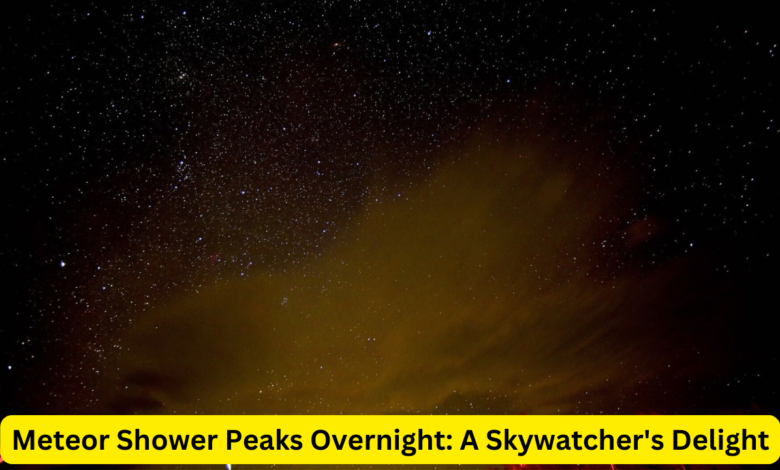Meteor Shower Peaks Overnight: A Skywatcher’s Delight

The annual Perseid meteor shower is set to peak overnight this Sunday, offering an exceptional opportunity for skywatchers to witness one of the year’s most dazzling shooting star displays. Known for its stunning visual spectacle and high meteor rates, the Perseids are a highlight of the annual meteor shower calendar. In this article, we’ll explore what makes the Perseids special, how to prepare for the peak night, and why this meteor shower is a must-see event.
What is the Perseid Meteor Shower?
The Perseid meteor shower is one of the most well-known and eagerly anticipated meteor showers of the year. It occurs every August as Earth passes through the debris left behind by the Swift-Tuttle comet. These debris pieces, known as meteoroids, burn up upon entering Earth’s atmosphere, creating the brilliant streaks of light we see as meteors or shooting stars.
Origins of the Perseid Meteor Shower
The Perseids are named after the constellation Perseus, from which the meteors appear to radiate. This meteor shower is associated with the comet Swift-Tuttle, which leaves a trail of dust and debris in its wake. As Earth travels through this trail, the meteoroids collide with our atmosphere, producing the spectacular light shows characteristic of the Perseids.
Why Are the Perseids So Special?
Several factors contribute to the Perseid meteor shower’s reputation as one of the best meteor showers of the year:
- High Meteor Rates: During the peak, observers can expect to see up to 60-100 meteors per hour, making it one of the most prolific meteor showers.
- Bright Meteors: The Perseids often produce bright, colorful meteors that can leave glowing trails in the sky.
- Warm Weather: The Perseids occur during summer, which means you can enjoy the shower in comfortable weather conditions, unlike many other meteor showers that happen in colder months.
When and Where to Watch the Perseids
To make the most of the Perseid meteor shower, it’s important to know when and where to look. Here’s how to prepare for the best viewing experience:
Peak Viewing Times
The Perseids are best viewed between midnight and dawn, when the sky is darkest. This year, the peak is expected to occur overnight Sunday, making it the prime time to see the most meteors. Arrive early to get settled and allow your eyes to adjust to the darkness.
Optimal Viewing Locations
For the best experience, choose a viewing spot away from city lights and other sources of light pollution. Open areas with an unobstructed view of the sky, such as a field or a park, are ideal. If you’re in an urban area, finding a high vantage point with minimal light interference can also work well.
What to Bring
While you don’t need any special equipment to watch meteor showers, a few items can enhance your experience:
- Comfortable Seating: Bring a reclining chair or a blanket to lie on.
- Warm Clothing: Even in summer, nighttime temperatures can drop, so dress warmly.
- Snacks and Drinks: Have some refreshments on hand to make your stargazing session more enjoyable.
How to Photograph the Perseid Meteor Shower
If you’re interested in capturing the Perseids on camera, here are some tips for photographing meteor showers:
Camera Settings
- Use a Wide-Angle Lens: A lens with a wide field of view will help capture more of the sky.
- Set a Long Exposure: A long exposure time (15-30 seconds) will increase the chance of capturing meteors.
- Use a Tripod: To avoid camera shake and ensure sharp images, use a sturdy tripod.
Composition Tips
- Include Landmarks: Adding a foreground element, such as a tree or building, can provide context and make your photos more interesting.
- Focus on the Sky: Ensure your camera is focused on the night sky, not on a distant object.
The Science Behind the Perseids
Understanding the science of meteor showers adds depth to your viewing experience. The Perseids are particularly fascinating because of their high speed and bright, long-lasting meteors. Here’s a closer look:
Speed and Brightness
Perseid meteoroids enter Earth’s atmosphere at speeds of around 37 miles per second (60 km/s). This high speed contributes to their brightness and the spectacular trails they leave behind. The intense friction with the atmosphere causes them to burn up and create a bright streak of light.
Interaction with Earth’s Atmosphere
As meteoroids enter the atmosphere, they encounter increasing air resistance, which causes them to heat up and ionize the surrounding air. This ionization process results in the glowing trails that are visible as meteors.
Historical and Cultural Significance
Meteor showers have captured human imagination throughout history, and the Perseids are no exception. Many cultures have interpreted these celestial events in various ways, often associating them with mythological or religious significance.
Mythological Connections
In Greek mythology, the Perseids are linked to the hero Perseus, who was said to be a son of Zeus. The meteor shower’s name reflects this connection, symbolizing a celestial tribute to the legendary hero.
Cultural Celebrations
Different cultures have celebrated meteor showers in unique ways. For example, in Japan, the Perseid meteor shower is known as the “Tanabata” festival, where people make wishes upon seeing meteors, hoping for their dreams to come true.
Additional Resources for Meteor Shower Enthusiasts
For those eager to delve deeper into meteor showers and enhance their viewing experience, the following resources can provide valuable information:
- NASA Meteor Watch: Offers updates and tips on upcoming meteor showers and other celestial events.
- Stellarium: An interactive planetarium software that helps you track meteor showers and other astronomical phenomena.
Conclusion
The annual Perseid meteor shower offers one of the most thrilling opportunities for skywatchers to experience the wonders of the night sky. With its high meteor rates, bright streaks of light, and comfortable summer viewing conditions, it’s a must-see event for anyone interested in astronomy. By understanding the science behind the Perseids, preparing for the peak viewing times, and utilizing tips for photographing the shower, you can make the most of this spectacular celestial event.
For more information and updates on meteor showers, visit NASA’s Meteor Watch and Stellarium.




One Comment